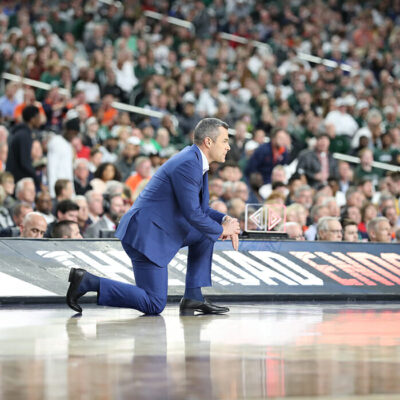Who died and made Leslie Feist our iPod queen, the digital age’s pop heir to Debbie Harry, equal parts lounge chanteuse and dance floor provocateur? For that matter, who taught her to play guitar like Robin Zander from Cheap Trick? How many crowds can she pacify with “1, 2, 3, 4” before she pulls out her long brown mane in frustration and, pun intended, wigs out on us, Björk-style? Does she deserve our attention as a performer more than we deserve our spotty satisfaction as an audience?

Leslie Feist
|
Feist has never been as poppy as a neon-blooded Apple commercial would lead you to believe. Baroque pop songs like “The Water”—think Beach Boys or Tori Amos or The Zombies—need an enclosed theater setting to be heard in all their ruffled intricacy. The video for her first single on her latest album, The Reminder, demands the same sort of attention as the stage construction of Talking Heads’ Stop Making Sense; her performance at the Charlottesville Pavilion was every bit the evolving handicraft of the Heads’ most famous live performance, a Brecht-meets-Byrne theater piece with an overhead projector. Basically, Feist requires all the attention of a few of your senses to be thoroughly enjoyed, and she’ll be hard-pressed to find that sort of concentration from any live audience.
| Video for Feist’s "1, 2, 3, 4." |
Yet Feist treated attention as something to be fought for—opening the show from behind a cream-colored scrim, singing “Help is on its way” over nothing but layered vocal loops, suspending the crowd on the hooks of her vocals and the silhouette of her body. After a ferocious run through “When I Was A Young Girl,” a predatory bossa nova beat that she supported with a distorted growl from her guitar, and the standard, sunshine-pop feel of “Mushaboom,” Feist led her band through more singles crafted to wrangle in stray listeners—the stomping “My Moon, My Man” and a rendition of “I Feel It All” that threatened to beat David Bowie’s “Modern Love” to the church.
And then she hit the middle of her set. Granted, it was leagues more enjoyable than opening act Hayden, a Coldplay-esque folkie whose musical palette bordered on monochromatic. But suddenly a gulf appeared: Feist, who lunged at the border between the stage and crowd like an ocean wave in a KISS t-shirt, seemed to recede. And the crowd, it should be noted—many in Foxfield-requisite seersucker, or overenergized by the Dogwood parade, or the rain, or simply talking too damned much—didn’t exactly reach out to her.
“We’re talking about whether we should keep playing, since you’re all ignoring us,” she remarked after a two-song block failed to overcome the tidal crest of chit-chat. Then: “O.K., here’s what we’ll do.”
A moment later, Feist casually tossed out “1, 2, 3, 4” and corralled her unruly crowd into a chorus. The hypnotic “Sealion” followed, all handclaps and barked backing vocals, and whipped the most complacent crowd members into a froth. The momentum was enough to carry the bulk of the crowd through the torch song and disco drizzle of “Let It Die,” a spectacular finale.
During the show’s entirety, a pair of stagehands dressed in black slacks and sweaters fluttered paper cutouts, leaves and muddy streaks across a projector on stage left, creating a series of short films that aligned lyrically or tonally with Feist’s set. Early in the set, one of these black-clad helpers moved to Feist’s side with a white stepladder and a bucket, climbed up the steps beside the singer and scattered white petals around her. Amidst the cold and rain of the night, the image suggested a wintry mix, a combination that excites and repulses you simultaneously—will it be mostly snow, or mostly rain? In the end, both the gesture and the show were like snow on a beach: A spectacle, unearthly and beautiful, but impossible to enjoy both at the same time.





